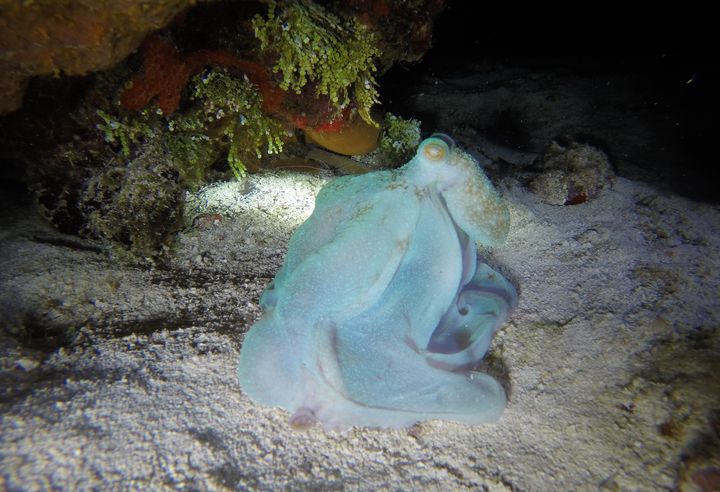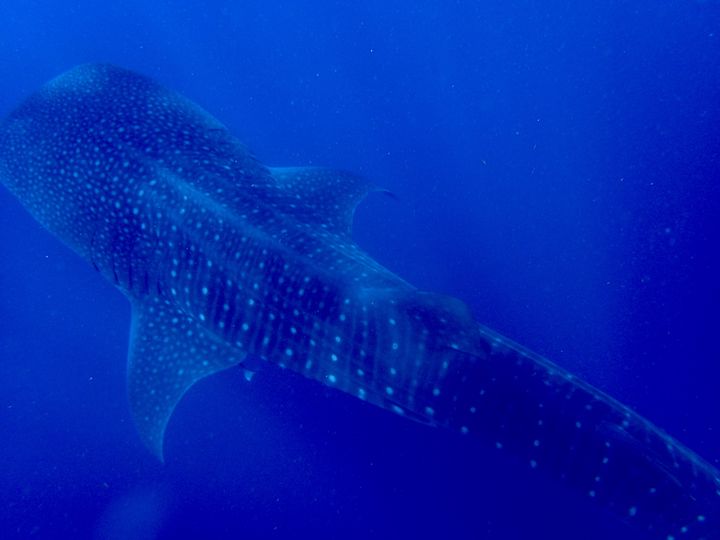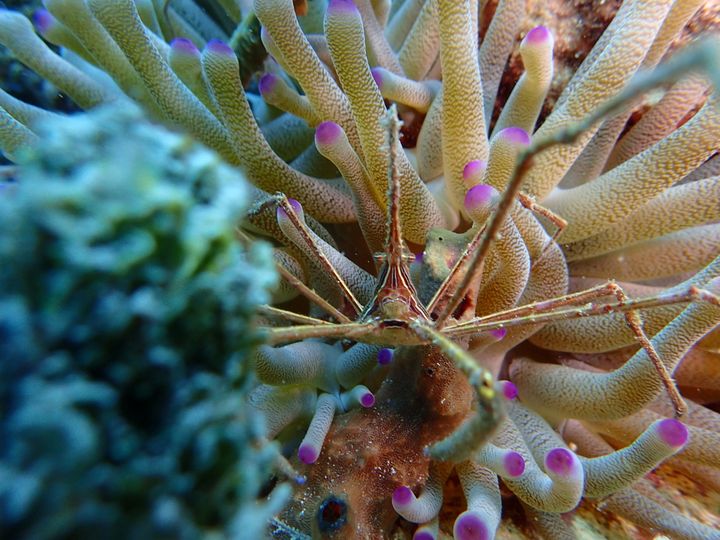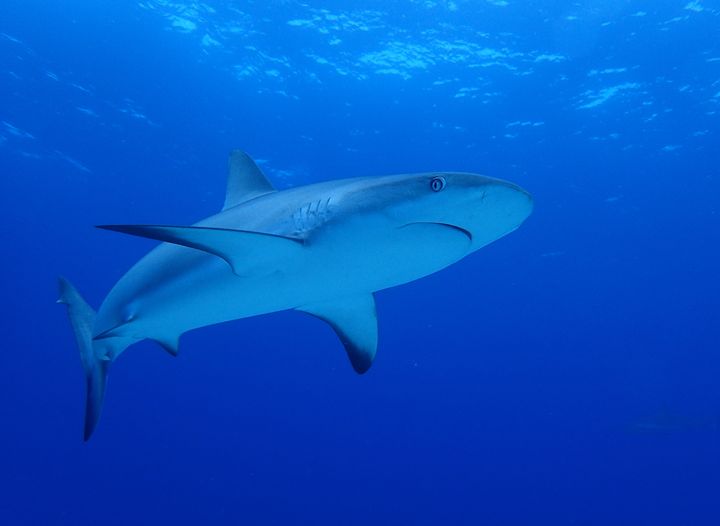
Beautiful moments like this one captured on a night dive motivate me to protect the ocean.
After breakfast at the hotel, we got out to catch a van to port and took in the sunny morning. Blue, open skies stretched overhead like an endless ocean, meeting their end only where the horizon cut a glassy blue division with water below. We drove to an outpost by the beach, a small shack with pictures of whale sharks and posters explaining coral reefs. A guide dictated the rules to us: there could be no more than three participants from our boat in the water at any given time, no more than 10 people on the boat, and anyone who attempted to touch the animals would get taken out of the water, no chance of being let back in.
Holbox Island, at the tip of the Yucatán peninsula in Mexico, is sparsely populated island (1,600 residents), part of a nature reserve boasting a large shallow lagoon, and is not yet visible on tourist maps. It’s said to be an idyllic natural paradise—full of sea birds, lobster, manatees in its lagoon and other sea life. But our speedboat wasn’t taking us to its coasts; instead we headed towards the open ocean.
Miles offshore, when no land was visible, the captain scanned the horizon. The glassy, calm surface made it easier to search today. He turned the radio on to listen for other captains, and switched course. Another boat had spotted whale sharks about a mile away. Catching my first glimpse of whale sharks felt magical—seeing the giants gracefully move below the waves, dorsal fins breaking the surface as their caudal fins, swaying gently side to side, propelled them.
I was part of the second group of 3 to jump in the water. It was a workout to keep up with the leviathans—their tail’s rhythmic movement belies their speed. But I was mesmerized by the scene—their grace, the patterns of their skin contrasting against the deep blue, the way their gills expanded and contracted into their bodies; their sheer size. I was glad to see park rangers appear, to inspect boats, observe interactions and ensure minimal disturbance to the sharks.

A whale shark cruises through the deep blue Caribbean Sea near Holbox Island, Mexico.
The whale shark aggregation off the coast of Holbox Island is the largest one there is (that we know about). From July to September each year hundreds of the biggest fish in the sea gather in an area of only a few square miles. Surely, an event of this size would draw attention—one would think.
The gathering was unknown to science until 2006. Meanwhile, shark populations around the globe, including those of whale sharks, are plummeting. Sharks are hunted for their meat and fins, often in areas of the High Seas, and national waters where fisheries management is nearly absent. Climate change, overfishing, plastic pollution, nutrient runoff, and ocean acidification also threaten their ecosystems worldwide. We may be losing species, ecosystems, and occurrences of the natural world like Holbox’s whale shark aggregation before we even have the chance to discover them. Ninety-five percent of the global ocean is unexplored. How much could we be losing that we don’t yet know?
We’ve protected only a tiny sliver of the global ocean –3.08% of it lies in marine protected areas, but only half of that is strongly protected. On paper. A subset of that portion is effectively managed, and has consistent enforcement in practice that conserves and restores critical ecosystems. It’s vital to have models of effective management, to recognize and reward protections not just on statute but physically in the sea.

A Yellowline Arrow Crab finds refuge between a sea sponge and an anemone. Cozumel, Mexico.
It’s as important to build a network of those reserves which allows for the interconnection of marine ecosystems, and represents the full range of biodiversity that exists in the ocean. Hence why I was glad to see rangers verify that only 3 people from our boat in Holbox were in the water at any given time although I wanted to spend more time with the sharks. Well-enforced reserves are a rarity.
The acute need for a global system of well-enforced marine reserves motivated me to support Marine Conservation institute’s newest initiative—the Global Ocean Refuge System (GLORES, pronounced glories—a phonetic play to emphasize the initiative’s aim of safeguarding the glories of marine life). The system aims to contain strongly protected areas that meet rigorous science-based standards for protection, representing 30% of each marine biogeographic region by 2030—a threshold recommended by marine conservation biologists.
GLORES will do so by recognizing and rewarding such areas, introducing a new incentive for governments to regulate and enforce protections, and for administrators to implement them effectively. The new award system—equivalent to Oscars™ for ocean protection, coupled with global leadership and action-inducing events like the International Marine Protected Areas Congress, and the Our Ocean Conference (the brainchild of Secretary of State John F. Kerry which continues to spur ocean action globally) can drive growth of strong, effective marine protection to increase at an exponential pace.
Ocean conservation leaders support the initiative. Sylvia Earle, a world-renowned marine explorer, chief scientist of NOAA under President Bush and founder of Mission Blue, has said, “The Global Ocean Refuge System is critical to saving the biodiversity of our oceans… We all should have thought of it a long time ago.” The support of other ambassadors like Leonardo DiCaprio, Oscar™ awardee and ocean advocate could spur the success of GLORES even further.
This year, the European Union will host the Our Ocean Conference in Malta October 5th to 6th. Already, countries and other stakeholders have made good on commitments made at last year’s conference. The international community’s leadership and the propelling force of GLORES can push marine protections to reach a new level. The Malpelo Flora and Fauna Sanctuary, a Colombian MPA and one of 3 inaugural GLORES awardees—reaching platinum status for its strong protections and enforcement—was already expanded to nearly 3 times its size by President Juan Manuel Santos after receiving its GLORES award, on September 14th. For his part, President Santos celebrated the designation of Malpelo as a Global Ocean Refuge and noted that the global recognition advances Colombia’s protection of its biodiversity.
GLORES also recognized Papahānaumokuākea Marine National Monument, the largest U.S. marine reserve, and one of the 5 largest marine reserves in the world, and Tubbataha Reefs Natural Park in the Philippines, a refuge for at least 600 fish species, 360 coral species, 11 shark species and 13 cetacean species. Considering the recent expansion of Malpelo’s Flora and Fauna Sanctuary, the Global Ocean Refuge System now contains more than 1.535 million square kilometers of protected ocean (by surface area) representing 3 distinct biogeographic regions, and half a percent of the global ocean (0.42%). Strong protections within Global Ocean Refuges, the establishment and expansion of more reserves which can be recognized within the system, and concerted global action spurred by leaders like Kerry, DiCaprio, Sir Richard Branson, and conferences like the Our Ocean Conference, can restore the ocean.
The metric for success of GLORES is an unusual though vital one—how well the system can restore abundance already lost, and preserve what’s left of marine biodiversity. Ecological balance, which GLORES helps maintain and rebuild, is crucial to ecosystem services the ocean provides—ocean circulation to temper the climate, production of oxygen, absorption of CO2 among many others. Humans depend in myriad ways on these services the ocean provides, so it is as vital to our survival as to that of marine species that GLORES succeeds.
In the end there will be many benefits from meeting GLORES’ goals—more fish, healthier oceans, beautiful reefs, and an abundance of life. But perhaps the most lasting and meaningful gain will be less tangible—measured in abundance, species diversity, unique ecosystems, and spectacular events of the natural world (like Holbox’s whale shark aggregation) – that we will be able to study, learn from, and experience because strong protections ensure they persist long enough for us to discover them.

A curious caribbean reef shark swims by for a look. Vulnerable marine life depends on ocean protection for its survival.
Sebastian Nicholls contributes to Marine Conservation Institute’s Global Ocean Refuge System initiative, a plan to protect 30% or more of each of the ocean’s biogeographic regions in well enforced MPAs. Marine Conservation Institute is dedicated to securing permanent, strong protection for the oceans’ most important places – for us and future generations. Learn more about the Global Ocean Refuge System by watching this video. Marine Protection is a primary theme of this year’s #OurOcean Conference organized by the European Union and taking place in Malta October 5th to 6th, 2017.
